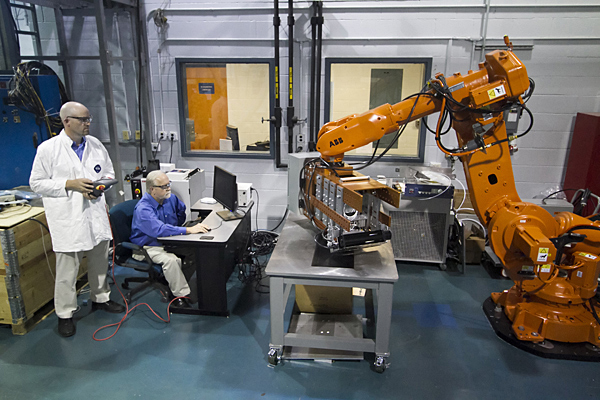
AMPing it up
Center for Composite Materials develops new tool for materials processing and design
1:20 p.m., Sept. 6, 2011--A giant tangerine-colored robotic machine in the Composites Manufacturing Science Lab at the University of Delaware promises to change the way new materials are evaluated and new processes are designed at UD’s Center for Composite Materials.
The custom-designed Automated Materials Placement (AMP) system is adaptable, modular and flexible, making it an ideal tool for conducting research on composites, which offer almost limitless combinations of fiber and matrix materials.
Research Stories
Chronic wounds
Prof. Heck's legacy
“Conducting research in composites manufacturing is an evolving environment as new materials and processing methods continuously enter the market,” says scientist John Tierney. “The AMP offers us a ‘plug-and-play’ approach to assessing new technologies.”
The AMP is configured with swappable modules for various feed systems, heating sources, and consolidation methods through a Lego-type connection structure. All of the modules use a common column design, and they all slide out the front of the chassis.
“Ideally, our goal is to enable any unit to be changed in under an hour,” says Shridhar Yarlagadda, assistant director of research at CCM. “The modular design allows multiple research projects to use the system with little downtime.”
Researchers at CCM have been investigating composites manufacturing science for almost three decades. “This new machine is truly a legacy research tool that builds on all of the previous work we’ve done on composites design and processing,” says director John W. (Jack) Gillespie Jr.
“Historically CCM has benefitted from having in-house equipment to aid in working with our industrial and DOD (Department of Defense) collaborators, and many of the workcells we developed for specific processes in earlier research programs laid the groundwork for this new capability.”
Like most advancements made at CCM, the AMP was a team effort including not only staff researchers but also industrial collaborators and students. Roman Weber, a visiting student from the University of Applied Sciences in Kaiserslautern, Germany, has been at CCM since March working on the AMP project. He plans to start doing experiments with the AMP system for his bachelor’s thesis within the next few weeks.
“It has been highly educational for a starting engineer like me to work on the entire development process cycle of the AMP system,” Weber says. “One of the most important things I learned is that you have to try to foresee any problems that could occur during assembly. Just because it looks good in the CAD (computer-aided design) model doesn’t mean it will work well in reality. You always have to keep in mind how the part will behave in real life.”
Over the coming months, the entire team at CCM will begin to see how the AMP behaves in real life. Their hope is that it will revolutionize the way new materials and processes are tested and optimized.
About the Automated Materials Placement (AMP) system
The AMP can process both thermoplastic and thermosetting materials up to 8 inches wide and can fabricate components in excess of 100 square feet. The system is designed to be modular so that various heating and consolidation methods can be studied and optimized with low risk on hardware investment. The flexible modules can be swapped or reordered to include high-energy infrared heating, volumetric induction heating, roller or shoe consolidation, sprayable bagging, ultrasonic welding, powder impregnation, and in-line fabric stitching.
The system is fully instrumented with thermal and modular force measurement capabilities as well as visual inspection and laser position sensors. Detailed design studies can be carried out to compare AMP process temperatures, pressures, and velocities on the final microstructure and the structural performance of a number of composite systems. The system as a whole provides an ideal environment for process design and optimization for a number of industries including aerospace, wind and automotive while generating original research findings for academia.
For more information about the AMP, contact John Tierney at 302-831-0548 or jtierney@udel.edu.
About composites manufacturing research at UD
CCM’s research in composites manufacturing science has been supported by the U.S. Army Research Laboratory, the Army Research Office, the Office of Naval Research, industry, the Defense Advanced Research Projects Agency, the National Academy of Sciences, the National Science Foundation, and the state of Delaware.
Article by Diane Kukich
Photo by Dawn Fiore








